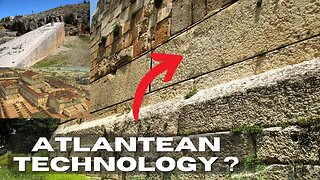Premium Only Content

The ancient Roman watermill complex that almost sparked an industrial revolution.
🔴 YOU WANT TO SUPPORT THIS CHANNEL? 🔴
🤗 Join our Patreon community: https://www.patreon.com/Maiorianus
🤗 One-Time Donation?
- PayPal: https://paypal.me/Maiorianus
- Bitcoin: bc1qv4lsfsplvfecrrgvmfclhga28we7mvh9563xdj
🔗 Share the video with anyone who might be interested (it helps a ton!)
👍 Subscribe to our videos FOR FREE!
📬 Contact us: maiorianus.sebastian@gmail.com
It is sometimes astounding to see how close the Romans came to some form of industrial revolution. Not only was the steam engine almost invented in Alexandria in the 1st century AD, but the Romans also built an industrial scale flour grinding complex at Barbegal, near the roman city of Arelate in southern Gaul. This incredible complex of 16 water wheels, arranged in two parallel sets of eight, was built such as to harness the full power of water, in order to use the kinetic energy for industrial applications. They were completed in the early 2nd century AD and operated for around 200 years, grinding massive amounts of grain every single day, and thus creating flour which would be baked into bread for the people of Arelate. It is estimated that 4.5 metric tons of flour were grinded there every single day. This was truly an industrial operation, which Europe would not see again in this form for 1500 years. But even though the spark of the industrial revolution did not manage to materialize in the Roman empire, it is said that the benedictine monks preserved and cultivated this ancient art of watermilling, inventing ever more elaborate uses of hydro energy, which would then in the 18th century britain contribute to the industrial revolution. So even though the Romans failed to industrialize, they were really quite close, and with a big delay, their knowledge contributed to our industrial revolution 1500 years later.
-
 19:24
19:24
Maiorianus
1 month agoWho Built The Massive Baalbek/Heliopolis Temple Complex? Romans, Atlanteans, or Somebody Else?
701 -
 44:49
44:49
Chrissy Clark
14 hours agoThe Rise Of Female Shooters, ABC News’ $16M Settlement, & MORE I Underreported Stories
9.17K3 -
 2:49:13
2:49:13
InfiniteWaters(DivingDeep)
22 hours agoIt's Over - The Matrix Is Cooked | Infinite Waters
6.54K4 -
 15:49
15:49
Chris From The 740
1 day ago $2.57 earnedThe EAA Girsan Influencer X - Not Your Grandpa's 1911
19K2 -
 25:38
25:38
Producer Michael
17 hours agoLuxury Souq's MULTI-MILLION DOLLAR Watch Collection!
80.1K5 -
 17:06
17:06
Sleep is CANCELED
22 hours ago10 SCARY Videos To Keep You Up All Night!
51.9K2 -
 2:37
2:37
Canadian Crooner
1 year agoPat Coolen | Let It Snow!
33.2K9 -
 2:44
2:44
BIG NEM
13 hours agoWhat's Really Behind the Fake Alpha Male Epidemic?
28K4 -
 57:20
57:20
State of the Second Podcast
7 days agoThe Inventor of Bump Stock Fights Back! (ft. Slide Fire)
19.2K5 -
 1:04:12
1:04:12
PMG
1 day ago $17.83 earned"I’ll be DRONED for Christmas!"
63.2K12